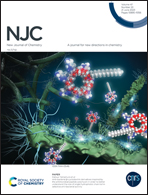DFT/TDDFT in silico design of ullazine-derived D–π–A–π–A dye photosensitiser†
Abstract
A set of ullazine-derived D–π–A–π–A photosensitisers were considered and selected for a potential dye with the best performance via computational approaches. The designed dyes HJ1–HJ13, which originated from dye YZ7, were constructed with different π-linking motifs and two kinds of auxiliary withdrawing groups. The photoelectric and photovoltaic parameters were determined by density functional theory approaches, and PBE0 optimisation with the TD-cam-B3LYP method was shown to be the best choice of functional in these designed dyes, with the calculated maximum absorption wavelength and excited lifetime in accordance with the experimental findings for YZ7. Replacement of the C![[triple bond, length as m-dash]](https://www.rsc.org/images/entities/char_e002.gif) C bond by the C
C bond by the C![[double bond, length as m-dash]](https://www.rsc.org/images/entities/char_e001.gif) C bond could reduce aggregation and improve the photoelectronic property. In addition, the D–π–A–π–A-type photosensitiser was found to achieve higher light-harvesting efficiency and higher performance for dye-sensitised solar cells (DSSCs). HJ8 was selected as the potential dye for DSSCs, as it had a 69 nm redshift in the maximum absorption wavelength and a 66% increment in the maximum extinction coefficient compared to YZ7, and achieved 99.9% light-harvesting efficiency, the longest excited time of 2.82 ns, a suitable driving force of injection and regeneration, the largest short-circuit current density and the largest open-circuit voltage. Our theoretical results provide strong guidance for discovering new efficient D–π–A–π–A-type organic dyes in DSSCs.
C bond could reduce aggregation and improve the photoelectronic property. In addition, the D–π–A–π–A-type photosensitiser was found to achieve higher light-harvesting efficiency and higher performance for dye-sensitised solar cells (DSSCs). HJ8 was selected as the potential dye for DSSCs, as it had a 69 nm redshift in the maximum absorption wavelength and a 66% increment in the maximum extinction coefficient compared to YZ7, and achieved 99.9% light-harvesting efficiency, the longest excited time of 2.82 ns, a suitable driving force of injection and regeneration, the largest short-circuit current density and the largest open-circuit voltage. Our theoretical results provide strong guidance for discovering new efficient D–π–A–π–A-type organic dyes in DSSCs.



 Please wait while we load your content...
Please wait while we load your content...